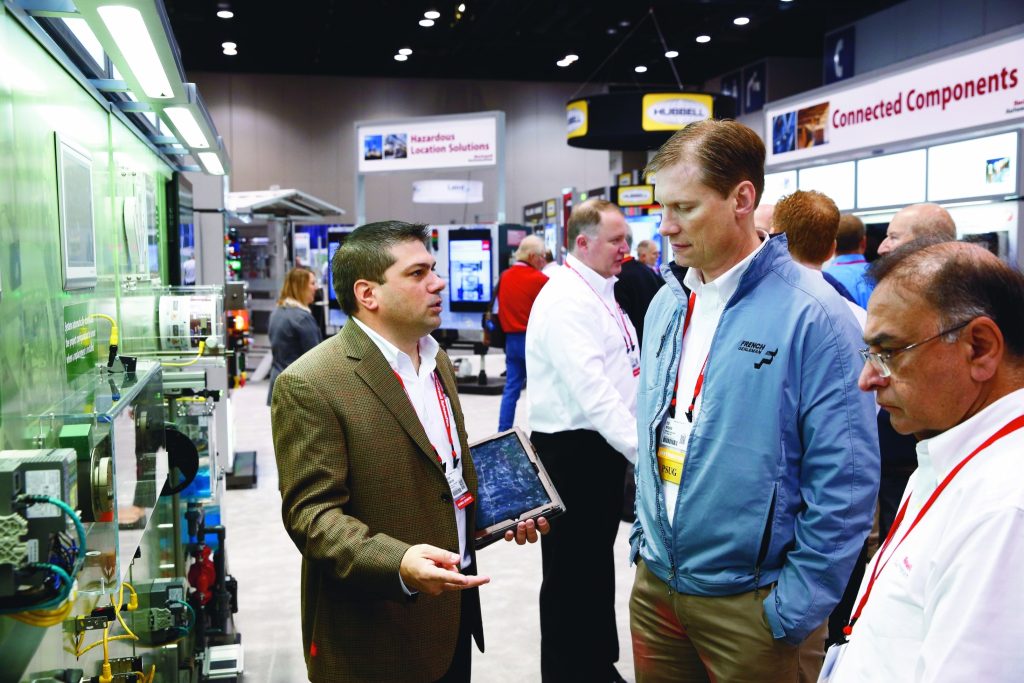In Q4 2015, Rockwell Automation held its annual Automation Fair in Chicago, USA. Logistics News ME was on hand to discover how The Connected Enterprise can help businesses achieve faster time to market and asset optimisation, while lowering ownership costs and enterprise risks
If the experts are to be believed, the world is on the cusp of the fourth industrial revolution. Information Technology (IT) is connecting with Operational Technology (OT) and initiatives are under way around the world to enable smart manufacturing, supported by digital communications and the Internet of Things (IoT).
Integration, digitasation and innovation are all spurring businesses ahead to achieve stronger and wider operations and, ultimately a more robust bottom line. On the back of this, a whole new industry is emerging one which assists in the navigation of new technologies and helps businesses integrate operations, for the benefit of themselves and client operations.
In Q4 2015, Rockwell Automation held its annual Automation Fair on these very issues in Chicago, USA. As the company explains: Theres no one-size-fits-all solution. Navigating new technologies and understanding their integration implications such as the need for more secure networks and better data management across enterprises requires guidance from automation experts and peers who have been there.
The Automation Perspectives global media event hosted by Rockwell Automation brought together industry experts and users to talk about todays most pressing issues in industrial automation. Users shared their progress, challenges, and successes in creating their own connected strategies, and explained how others can learn from their experiences.
The Enterprise in Operation
Among the many resources distributed to delegates at the fair, was a white paper assessing How to move from discussing and theorising a connected enterprise to rationalising and operationalising it. It was one of the key focuses at the fair.
Launching a connected enterprise involves several people, decisions and processes and so Rockwell Automation designed a related Connected Enterprise Maturity Model based on five key stages:
Stage 1: Assessment
Stage 2: Secure and Upgraded Network and Controls
Stage 3: Defined and Organised Working Data Capital
Stage 4: Analytics
Stage 5: Collaboration
Ideally, each stage should be assessed, designed and implemented with the others in mind. However, while it is important to note that they are not mutually exclusive and that in some ways these stages are dependent upon each other, businesses may initiate the process by entering the phase most appropriate for each organisation and its unique needs.
A Roadmap: The 5 Stages of The Connected Enterprise Execution Model
To help its customers make the technology and cultural changes essential to reach The Connected Enterprise goals, Rockwell Automation developed a five-stage process that can help protect operations against emerging IoT threats.

Without a solid infrastructure you cant achieve the desired value youre looking for. Therefore a comprehensive infrastructure and network assessment will establish to what extent it can be upgraded, or whether it needs replacing.
Secure and upgraded network and controls
Applying standard Internet and Ethernet protocols like EtherNet/IP (CIP version) helps integrate operations data with the rest of the enterprise and future-proofs in relation to the ongoing growth in Internet enabled devices.
Defined and organised working data capital
Capturing data is fundamental, but data without context is not an asset. The Connected Enterprise makes the best use of data, transforming it into actionable business information on which better decisions can be based.
Analytics: Operational benefits
Data-based analytics can be viewed real-time with dashboards, and can be monitored contextually as well as against historical performance data. It also can be securely shared and presented organisation-wide using bespoke, secure reports.
Optimise and collaborate
The Connected Enterprise unites and shares valuable information not just across people, devices and processes, but also across sites. Information is even shared across the supply chain, ensuring processes are optimised
end to end.
Next generation launch
Also during the fair, Rockwell Automation launched its next-generation Integrated Architecture Portfolio, which is designed to enable and support the Connected Enterprise.
The expanded next-generation Integrated Architecture portfolio from Rockwell Automation reduces complexity while helping users meet future capacity and throughput needs as they design systems for a Connected Enterprise.
The portfolio includes a newly released next-generation Allen-Bradley controller, graphic terminal, servo drive and distributed I/O system, as well as the latest release of the Rockwell Software Studio 5000 and FactoryTalk software offerings.
Weve invested significantly in the Integrated Architecture portfolio to help our customers prepare their production environments for future growth, and help machine builders simplify machines and get them to market faster, said Dan DeYoung, market development director, Integrated Architecture, Rockwell Automation. With this new portfolio and our ongoing collaboration with our PartnerNetwork members, customers have the tools to more easily design, operate and maintain smart, high-performing systems.
The expanded portfolio also incorporates a number of security features to help manufacturers and industrial operators protect their facilities, assets and intellectual property
Industrial workers are increasingly turning to mobile devices to improve productivity and collaboration. However, interfaces need to be tailored to the specific device that is being used, especially to design, operate and maintain industrial automation systems. To meet this user preference, Rockwell Automation and Microsoft Corp. have announced a mobility co-innovation project designed for industrial environments where a wireless network connection is not always reliable.

The mobility developments support The Connected Enterprise vision: the convergence of operations and information technology that will deliver the next wave of manufacturing productivity. Enhanced by the emergence of the Industrial IoT and advances in enabling technologies including mobility, data analytics, and remote monitoring The Connected Enterprise creates opportunities for benefits in productivity and global competitiveness through greater connectivity and information sharing.




